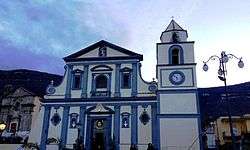Sarno
| Sarno | ||
|---|---|---|
| Comune | ||
| Comune di Sarno | ||
|
The St. Michael Cathedral | ||
| ||
 Sarno Location of Sarno in Italy | ||
| Coordinates: 40°49′N 14°37′E / 40.817°N 14.617°E | ||
| Country | Italy | |
| Region | Campania | |
| Province / Metropolitan city | Salerno (SA) | |
| Frazioni | Foce, Episcopio, Lavorate | |
| Government | ||
| • Mayor | Giuseppe Canfora | |
| Area | ||
| • Total | 39 km2 (15 sq mi) | |
| Elevation | 30 m (100 ft) | |
| Population (31 449)[1] | ||
| • Total | 31,463 | |
| • Density | 810/km2 (2,100/sq mi) | |
| Demonym(s) | Sarnesi | |
| Time zone | CET (UTC+1) | |
| • Summer (DST) | CEST (UTC+2) | |
| Postal code | 84087 | |
| Dialing code | 081 | |
| Patron saint | St. Michael | |
| Saint day | May 8 | |
| Website | Official website | |
Sarno is a town and comune and former Latin Catholic bishopric of Campania, Italy, in the province of Salerno, 20 km northeast from the city of Salerno and 60 km east of Naples by the main railway.
Overview
It lies at the foot of the Apennine Mountains, near the sources of the Sarno River, called Sarnus in ancient times, a stream connected by canal with Pompei and the sea.
Paper, cotton, silk, linen and hemp are manufactured. The travertine which forms round the springs of the Sarno was used even at ancient Pompeii as building material.
History
The area of Sarno was inhabited since Neolithic times, and in pre-historical times housed Oscan and Samnites settlements. Later it was acquired by the Romans, who held it until the fall of the Western Roman Empire in the 5th century AD. The first nucleus of the future Sarno grew in the 8th century around a castle founded by the Lombards of Benevento.
Before its incorporation to the domains of the crown of Naples, Sarno gave its name to a county held in succession by the Orsini, Coppola, Tuttavilla, and Colonna families.
On May 5, 1998 Sarno and the neighbouring villages of Quindici, Siano and Bracigliano were devastated by a series of landslides. 180 houses were destroyed, 450 severely damaged, and 161 people died in what was one of the biggest catastrophes of its kind in modern Italy. The landslides had been caused by several days of torrential rainfalls, but were also blamed on agricultural, residential and industrial overexploitation and the lack of any substantial environmental programs. The catastrophe prompted the Italian Ministry of the Environment to introduce a couple of legislative measures for environmental protection which have come to be known as legge Sarno.
Ecclesiastical History
The Diocese of Sarno was established Circa 1000 AD, presumably as suffragan of the Roman Catholic Archdiocese of Oristano. In 1534 it lost territory to the Diocese of Nola. The neighboring bishopric of Cava de’ Tirreni was held in personal union with Sarno (united aeque principaliter) from 1818.06.27 till 1972.09.25.
Suppressed on 1986.09.30, its territory and title being merged into the thus renamed Diocese of Nocera Inferiore–Sarno.
Episcopal Ordinaries
(all Roman Rite)
- Suffragan Bishops of Sarno
(without ordinals; first incumbent(s) lacking?)
- Riso (1066? – ?)
- Giovanni (1111 – 1118)
- Giovanni (1119 – 1134)
- Pietro (1134 – 1156)
- Giovanni (1156 – 1180)
- Unfrido (1180 – 1202)
- Tibaldo (1201 – 1208)
- Ruggiero (1209 – 1216)
- Giovanni (1216 – 1224)
- Giovanni (1224 – 1258)
- Angelo d’Aquino (1258 – 1265)
- Giovanni (1265 – 1296)
- Guglielmo (1296 – 1309)
- Ruggiero De Canalibus (1310 – 1316)
- Ruggiero (1316 – 1316)
- Ruggiero De Miramonte (1316 – 1324)
- Antonio da Ancona (1324 – 1326)
- Napoleone (1326 – 1330)
- Nicola (1330 – death 1333)
- Francesco, Friars Minor (O.F.M.) (1333.03.13 – 1340)
- Napoleone (1340 – 1350)
- Teobaldo (1350.04.25 – 1370)
- Giovanni (1372 – 1404)
- Giovanni (1404 – 1407)
- Francesco Mormile (1407 – 1408), later Bishop of Cava (Italy) (1408 – 1419)
- Giovanni (1408 – 1414)
- Francesco Anconitano (1414 – 1419)
- Marco da Teramo (1418.12.29 – death 1439); previously Bishop of Monopoli (Italy) (1400.03.24 – 1404.12.15), Bishop of Bertinoro (Italy) (1404.12.15 – 1418.12.29)
- Andrea da Nola (1439.10.23 – 1454)
- Ludovico Dell’Aquila (1454 – 1470)
- Antonio de’ Pazzi (1475 – 1477.02.26), later Bishop of Mileto (Italy) (1477.02.26 – death 1479)
- Giovanni da Viterbo (1478.09.30 – 1481.02.16), later Bishop of Crotone (Italy) (1481.02.16 – death 1496.11.25)
- Andrea De Ruggiero (1481.02.16 – 1482)
- Andrea Dei Pazzi (1482.02.16 – 1498)
- Agostino Tuttavilla (1498 – 1501)
- Giorgio Maccafani de’ Pireto (1501 – 1516), previously Bishop of Civita Castellana e Orte (Italy) (1498.09.24 – 1501)
Main sights
Sarno has the ruins of a medieval castle, which belonged to Count Francesco Coppola, who took an important part in the conspiracy of the barons against Ferdinand II of Aragon in 1485. Walter III of Brienne is buried in the ancient church of Santa Maria della Foce, rebuilt in 1701. The Sarno Cathedral is near the town center.
Twin towns
 Abergavenny, Wales, since 1998
Abergavenny, Wales, since 1998
References
Sources and External links
![]() This article incorporates text from a publication now in the public domain: Chisholm, Hugh, ed. (1911). "article name needed". Encyclopædia Britannica (11th ed.). Cambridge University Press.
This article incorporates text from a publication now in the public domain: Chisholm, Hugh, ed. (1911). "article name needed". Encyclopædia Britannica (11th ed.). Cambridge University Press.
![]() Media related to Sarno at Wikimedia Commons
Media related to Sarno at Wikimedia Commons


